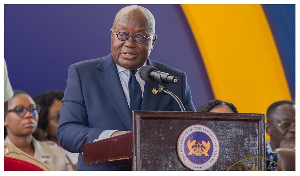Overall poverty declined considerably in Ghana in the 1990s, but the incidence of extreme poverty is still high, according to the fourth Poverty Level Report by the Ghana Statistical Service launched in Accra on Monday.
This suggests that reduction in poverty is likely to be experienced mostly by only those who are close to the poverty line.The poor, however, did not experience much improvement in their standard of living because they are incapable of taking advantage of existing opportunities.
Dr Kweku A. Twum-Baah, Acting Government Statistician, said at a dissemination seminar to launch the report that the decline, however, was not experienced evenly across the country.
"It was felt the most in Accra and the forest zone, while the proportion increased in urban savannah." The Poverty Report published together with the fourth in the series of Ghana Living Standards Survey (GLSS4) said the incidence of poverty at the upper line declined from 51.7 per cent in 1991-1992 to 39.5 percent in 1998-1999.
The GLSS provides benchmark data on a continuing basis to the government for measuring the living standards of the population and the efforts to raise them. It is also to support the formulation and implementation of medium to long-term poverty alleviation strategies.
Dr Twum-Baah said poverty was substantially higher in rural areas than in urban areas. In the rural and urban areas, poverty is more concentrated in the savannah area.
"If the poverty line set in the GLSS3 is used, incidence of poverty moves from 31.4 per cent in 1991/1992 to 28.0 per cent in 1998/1999," Dr Twum-Baah said.
He said if poverty reduction programmes are implemented in a general way, the not-so-poor are likely to continue taking advantage of the opportunities provided by the social system.
Dr Twum-Baah said: "If the very poor are to come out of their dehumanising situation, they would have to be specifically targeted for intervention, even as Jesus singled out the lame man for healing."
He said evidence shows that the poorest groups - food crop farmers and rural areas in rural savannah - have benefited the least from the growth in average consumption expenditure, and so deserve policy attention.
Dr Twum-Baah said a series of zonal dissemination seminars would take place from November 1-11 in Tamale, Kumasi and Elmina for regional and district dministrators, NGOs and representatives of civil society.
"The objective would be to create greater awareness and use of the GLSS data and discuss ways of using the benchmark data to monitor and measure the effectiveness of programmes on living standards."
On methodology used during the survey, Dr Twum-Baah said because of the long period between the 1984 census and 1998 when the survey was conducted, enumeration areas selected were not picked with probability proportional to their true size since the number of households would have grown at different rates.
He said preliminary data from the just-ended census have now been used to generate appropriate weights to apply to the survey data. He said the GLSS4 was based on "calorie requirements."
"In doing this, two nutritionally-based poverty lines have been set, based on defined minimum consumption of households (using adult equivalent scales instead of simple per capita consumption).
"Another measurement procedure has been to exclude, from the household consumption aggregate, items that would not improve standards of living, such as expenditure on major hospital treatment and remittances to their households."
Dr Twum-Baah said: "A lower poverty line that corresponds to a minimum calorie requirement of 2,900 kcal per equivalent adult of 700,000 per year defines extreme poverty.
"An upper poverty line that makes provision for essential non-food expenditure beyond the minimum calorie requirement or 900,000 cedis per adult a year, is defined as the poor. The proportion of the population that lies above the upper poverty line is defined as the non-poor."
Dr Twum-Baah said the GLSS survey indicates that the country has a youthful age structure, with the population under age 15 accounting for about 44 per cent while 49.9 per cent are under the age of majority.
"The age structure suggests a dependency ratio of 96, which means that every working adult on average has one additional person to support," he said.
The average household size in 1998/199 was 4.3 as against 4.5 in 1992/1992. On economic activity, Dr Twum-Baah said the survey indicated that 82 per cent of adults aged 15-64 years are in some gainful employment. More than half, however, worked less than 40 hours per week, indicating a high degree of underemployment.
The survey put adult unemployment rate for Ghana at 8.2 per cent. "Agriculture remains the dominant economic activity, with 55 per cent of adults working in that sector. The highest hourly rates are obtained in mining and quarrying, followed by financial services and trading," the survey said.
For all sectors of employment, females earn lower than males. It also shows that 29 per cent of children aged 7-14 years are engaged in economic activity, which is a clear case of child labour. Dr Twum-Baah said:
"In many households, especially in rural areas, family members, particularly women spend a great deal of their time fetching water and firewood in addition to cooking."
The survey noted significant improvement in housing conditions in the 1990s, especially for urban households. Additionally, it put household consumption expenditure - cash and imputed - in 1998 and 1999 at 4.2 million cedis or 987,000 cedis per person a year.
Food constituted the largest share of 45.4 per cent of total cash expenditure, with an extra 10.3 per cent for consumption of food produced by the persons themselves
General News of Tuesday, 31 October 2000
Source: GNA
















